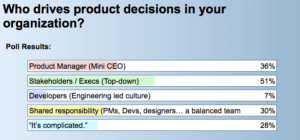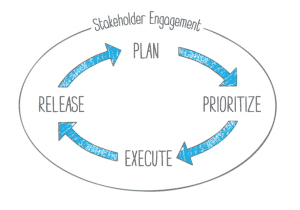What are Stakeholders?
Stakeholders are individuals (or groups) that can either impact the success and execution or are impacted by a product. The first “upstream” category includes everyone who must contribute to or approve the activities required to design, build, and bring the product to market. The second “downstream” batch consists of both those who purchase or use the product and those who must support, sell, and market it.
Why are Stakeholders Important to Product Managers?
Products aren’t built in a vacuum; it takes lots of resources and supports to create them, more to successfully sell and distribute them, and even more to help them in the field. Since they wield a disproportionate amount of influence in a product manager’s ability to execute, securing the favor and avoiding the wrath of stakeholders is of paramount importance.
When supportive, stakeholders can grease the wheels of progress for product teams, whether it’s allocating budgets, quashing the concerns of doubting coworkers, wooing essential customers, or simply providing their stamp of approval whenever called upon. An engaged and excited stakeholder creates momentum for the entire initiative and frees product managers from feeling like they’re Don Quixote taking on windmills.
However, stakeholders can also make a product manager’s life difficult when they’re not fully on board. Not only can they withhold their endorsement and support, but other stakeholders may take notice of their reluctance and similarly fail to provide consent when it’s needed most.
The key to winning over stakeholders
With these hard truths in mind, product managers must win over stakeholders for a given project and cultivate strong relationships with them. This relationship will yield value in the future, so they are by default inclined to trust and agree with product management’s recommendations. Having that solid and established foundation makes it easier to convince them of things down the line when they’re less confident about a particular topic.

Who Are Your Stakeholders?
Although some stakeholders are apparent, some may be less discernible at first glance. When product managers get started at a new company or begin working on a different product, it’s helpful to take the time and perform some stakeholder analysis to identify who may be relevant for that particular situation.
Regardless, stakeholders typically have a few common characteristics:
- Their opinion matters—Everyone has an opinion, but product managers don’t have to listen to all of them. But stakeholders have enough influence and strategic importance to the business that their idea is important and can impact the ability to advance the product strategy, create a roadmap, and execute it.
- They have a clear perspective concerning the product—Not only do stakeholders have meaningful opinions, but it’s evident why they care about it. Internal executives want to make sure the product is aligned with corporate strategy and hitting its numbers. If they’re in a related department (such as sales, technology, or support), their daily lives are impacted by product decisions. Investors and board members are worried about financial performance, market share, and valuation. Partners and suppliers have a vested interest in how the product impacts their businesses. Finally, key customers are worried about how the product will continue to support their needs and increase its value over time.
- Stakeholders have something product managers need—Whether it’s information, approval, budget, cooperation, or a more tangible deliverable, product teams need stakeholders to deliver on their end to move things forward (even if it’s just silent approval).
- Stakeholders aren’t easily replaceable—A stakeholder’s importance is tied to the unique value they bring to the table. While the individual filling the role might be swapped out, the CFO still must bless the pricing plan, etc.
Identifying your stakeholders
With those criteria in mind, it’s an excellent exercise to brainstorm a bit and see who might qualify. While there are some obvious candidates, opening the process up might uncover a few less apparent stakeholders.
The first step is to ask around—whose opinion matters around here—analyze the org chart and understand how decisions are made. But beyond those individuals whose stakeholder status is self-evident, there are usually others that require a bit more research and creative thinking to identify. The following actions may help uncover those other significant parties:
- Ask sales, account management, and customer support which customers throw their weight around and have an outsized influence within the company.
- Talk to operations and the delivery personnel and identify which third-party partners and suppliers can significantly impact affairs and would benefit from being both informed of plans and convinced that it’s to their benefit as well.
- Try to spot the squeaky wheels in the organization who—despite not having a rank to warrant automatic stakeholder status—can make enough trouble and disruptively drag their feet on things.
- See who drives the narrative for the company’s messaging and could impede a product launch’s success if they’re not entirely convinced of its merits.
- Identify any third-party organizations that can influence the product’s success, including any industry groups, regulatory agencies, or standards bodies that might raise a fuss if the project runs afoul of their preferences and rules.
- Depending on the nature of the product, there may also be communities impacted by its introduction and any changes in functionality or pricing models. Providing them with information and allowing community input could spell the difference between a successful launch and vocal protests from the expected customer base.
What’s next?
After compiling the list, it’s often beneficial to categorize them into a few buckets. This is both helpful for keeping them organized and for communicating with them in the future (i.e., using the same messages and channels for each grouping).
What Are Communication Strategies with Stakeholders?
Stakeholders have varying levels of engagement and interest in any given product, regardless of their strategic importance in its success. There isn’t necessarily a direct relationship between those most engaged and those most critical either; a relatively minor stakeholder could be pretty interested and active with a product while someone far more critical might only occasionally chime in.
Product managers should therefore communicate with various stakeholders accordingly. Those that are both highly engaged and have a lot of power should be regularly updated and monitored. Similarly, engaged but less powerful stakeholders should be informed frequently while their tacit approval and buy-in shouldn’t be sought out too often.
Meanwhile, those stakeholders with lots of power but little engagement should get just enough information to make crucial decisions while not being overloaded with more updates than they need (although any requests they have should be promptly addressed). And for those who are both relatively uninterested and not particularly powerful, occasional, general updates should be plenty as they don’t require much individual attention or personalized briefings on developments.
Understanding the motivations for each stakeholder and considering what else is on their plate is helpful in tailoring messages to each individual. Knowing their starting point and competing priorities makes it much easier to craft compelling communication.
When possible, come up with a predictable cadence for stakeholder updates. This ensures they’re getting updates semi-regularly and avoids leading them into thinking they’re being ignored or forgotten. Even a temporary status can be better than nothing during slow periods.
How are Stakeholders Involved with Roadmaps?
Stakeholders have plenty of good things to offer to the roadmapping process. They each have their areas of expertise, career experiences, and anecdotal evidence from the market. Unfortunately, they also show up with their own biases, priorities, emotions, and opinions that may not be particularly universal or helpful to the process.
Separating what’s valid from what’s noise can be tricky, especially when trying to appease the egos of the people that can make a project a success or completely derail it thanks to their influential power.
Managing expectations is key.
One point to consider is that stakeholders are often some of the biggest fans and supporters of the product; they’ve taken a job with the company, invested in it, or partnered with it, so they have big expectations and high hopes. Managing those expectations is tricky, but this is where the roadmap can be a big help.
Instead of letting them loose on the endless list of potential features and enhancements added to the product, the roadmap can provide a focal point and elevate the conversation to a more strategic level. This is where stakeholders should be residing anyway. It gets them out of worrying about specific line items and instead allows them to take a big picture view of where things are heading; while channeling their enthusiasm to major themes instead of individual items.
Lead with data.
Something product managers have that most stakeholders don’t possess relevant data to the product planning process. Product managers should heavily lean into that when working with stakeholders. This not only indicates that product management isn’t just winging it or trusting their gut; it educates stakeholders so they can reach their own conclusions based on facts, not hunches.
Emphasize the ‘why.’
To effectively integrate stakeholders into product roadmapping, they should be engaged at every point in the process. During the planning phase, it’s best to make them aware of where things are heading and why. This is both a tone-setter for future discussions and an opportunity to get contractual input early on.
While the overall product strategy should drive most prioritization, it’s still worthwhile to check in with each stakeholder to understand what’s most important to them. With this lens included in the prioritization process, product managers may spot some ignored trends or throw stakeholders a bone by getting something vital to them included a little earlier than initially planned.
During the execution, product managers aren’t the only ones who care about who’s doing what and when it will be delivered. Status updates, resource allocation, and unexpected developments are all appropriate for stakeholder communication. As the release approaches, it’s another opportunity to check back in with stakeholders to be sure they’re prepared, know their role in making things successful, and have the resources available to support the big event.

